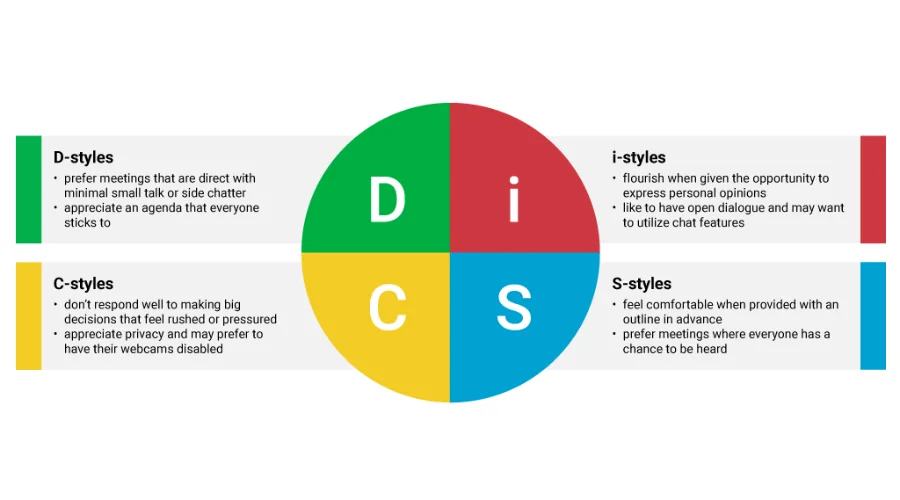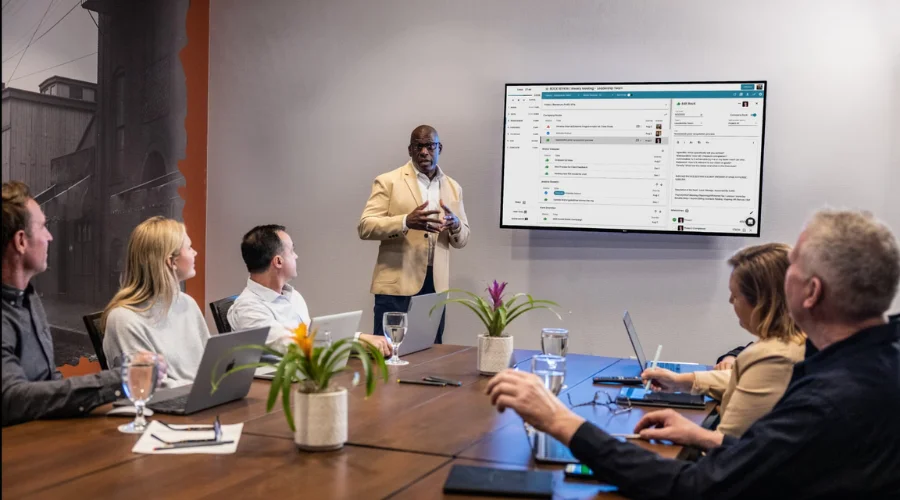Table of content
DISC Working Styles: Understand Your Style and Work Better with Team
Unlock the power of DISC working styles to boost teamwork, communication, and leadership. Discover your style and learn how to work smarter with any team.
Have you ever wondered why collaboration feels effortless with some people but challenging with others? The answer lies in understanding DISC working styles - the key to unlocking better communication, stronger teamwork, and higher performance. This guide will help you discover your natural style, recognize others’ strengths, and adapt your approach to achieve lasting success together. Let’s uncover how DISC working styles can elevate the way you work and connect.
What Are DISC Working Styles?
DISC working styles describe the natural behaviour patterns that shape how people approach tasks, make decisions, and communicate with others. These styles do not measure intelligence or ability. Instead, they show how someone prefers to act, react, and interact in a work environment.
The DISC working model includes four main behaviour types: Dominance, Influence, Steadiness, and Compliance. Each type highlights a distinct approach to working and interacting with others.
Understanding your DISC working style helps you recognise what motivates you and how you respond under pressure. It also enhances your ability to collaborate with others who may think or act differently.
In business and team settings, applying DISC working types can strengthen communication, reduce conflict, and improve productivity. When you know your own style - and respect others’ differences - you create stronger professional relationships and achieve better results together.

Why Working Style Matters At Work
Knowing your DISC working styles helps you work smarter, communicate better, and build stronger relationships. It’s not just about personality—it’s about improving real results at work.
How Working Style Shapes Communication
Every person has a unique way of expressing ideas and responding to others. Understanding your DISC working helps you adapt to different communication preferences:
- Dominance (D) types often speak directly and focus on quick decisions.
- Influence (I) types are expressive, people-focused, and thrive on interaction.
- Steadiness (S) types prefer calm discussions and steady collaboration.
- Compliance (C) types value accuracy and well-organized information.
Recognizing these differences makes teamwork smoother and reduces conflict.
Learn how these styles influence career paths by reading DISC Personality Types for Careers. It explains how each type thrives in specific professional environments.
Aligning Working Style With Daily Tasks
Your working style affects how you plan, prioritize, and perform tasks. Matching your behavior pattern to your role increases efficiency and motivation.
For example:
- A C-style employee works best with structured systems and detailed tasks.
- An I-style professional shines in social or creative roles.
When job demands fit your style, productivity rises—and stress drops.
Strengthening Relationships Through Awareness
Teams succeed when members understand one another’s work preferences. Awareness of DISC working styles helps you:
- Handle disagreements calmly.
- Respect different speeds and approaches.
- Build trust through better understanding.
This awareness creates a workplace where people feel valued and supported, not misunderstood.
Fostering Growth And Adaptability
Understanding your DISC working styles is the first step toward personal growth. Once you know your strengths, you can also stretch beyond them.
Employees who adapt their style:
- Communicate more effectively.
- Adjust faster to new challenges.
- Deliver stronger performance across teams.
Learning to balance your natural style with flexibility is what turns good professionals into great ones.
Understanding how DISC styles affects communication is essential. If you're looking to improve your team's dynamics, check out DISC Communication Styles for tips on how to tailor your interactions based on different styles.
The Four DISC Working Styles
Understanding the DISC working styles helps you recognize how people behave, communicate, and contribute at work. Each style has distinct strengths that shape how individuals make decisions, solve problems, and interact with others.

Dominance (D) Style
People with the Dominance style are confident, action-oriented, and determined to achieve results. They enjoy challenges, take initiative, and prefer to lead rather than follow. People with D-style are often goal-driven and thrive in fast-paced environments where quick decisions matter.
Key Traits:
- Assertive and direct communicator
- Goal-driven and highly competitive
- Focused on quick decisions and clear outcomes
The D type fits best in roles requiring strong leadership and measurable success. Investing in working styles training for D-style employees can enhance productivity and empower decisive, high-impact leaders.
Influence (I) Style
Those with the Influence style are outgoing, enthusiastic, and thrive on social interaction. They bring energy to the workplace and often serve as the “motivators” who inspire and connect others. I-type individuals enjoy sharing ideas, building relationships, and creating a positive, engaging environment.
Key Traits:
- Friendly and persuasive communicator
- Builds strong professional connections
- Brings positivity and energy to the workplace
Organizations that understand the I style can improve employee engagement, teamwork, and workplace culture. Applying DISC working insights helps match these individuals to roles where creativity and collaboration thrive.
Steadiness (S) Style
Those with the Steadiness style value stability, cooperation, and trust. They perform best in supportive environments and often act as the calm force within a group. Their approach is patient and empathetic, making them excellent at resolving conflicts and maintaining trust among colleagues.
Key Traits:
- Dependable and patient team player
- Focused on steady performance and long-term goals
- Excellent listener who supports others
When selecting a DISC working styles test, consider how the S type sustains harmony and consistency across teams. Their reliability makes them vital for maintaining smooth operations.
Compliance (C) Style
People with the Compliance style are analytical, precise, and structured. They prefer clear systems, rules, and detailed procedures that ensure accuracy and quality in every task. Their strength lies in their ability to think critically, spot inconsistencies, and maintain high standards in their work.
Key Traits:
- Detail-oriented and methodical
- Values data, organization, and thorough analysis
- Strives for excellence and consistency
The C style aligns with roles that demand careful planning and technical precision. Businesses using working styles profiling can leverage these strengths to build reliable systems and improve overall performance quality.
For more on how these styles manifest in team dynamics, check out DISC for Team Building and learn how applying DISC test can enhance collaboration.
How to Identify Your DISC Working Style
Discovering your DISC working style helps you recognize how you act, communicate, and perform at work. Follow these three simple steps to pinpoint your style and apply it effectively in your job or team environment.
Take a Validated DiSC Assessment
Start by taking a certified DiSC assessment. It’s a short questionnaire that measures your behavior patterns and work preferences. There are no right or wrong answers - only honest ones that reflect how you naturally respond at work.
Once you finish, you’ll receive a personalized report showing your dominant and secondary traits within the DISC working styles model.
Benefits of taking the assessment:
- Gain clear insight into your professional strengths.
- Identify how you approach goals, teamwork, and communication.
- Make more confident career or leadership choices with the help of your DiSC style coach letters included in the report, which explain each style’s behavior in simple, practical terms.
Read Your Report & Map Behaviors to Work Situations
Next, review your profile and relate each point to your daily tasks. The report highlights your primary and secondary styles and explains how they influence your decisions, pace, and teamwork.
For example:
- Dominance (D): Fast-paced, direct, and goal-oriented.
- Influence (I): Outgoing, enthusiastic, and people-focused.
- Steadiness (S): Calm, reliable, and team-driven.
- Compliance (C): Precise, cautious, and detail-oriented.
By connecting these traits to real work moments - like leading meetings, solving problems, or managing time - you’ll see where your natural strengths fit best.
Self-Reflection Questions for Your Working Style
To get the most from your DISC working style, ask yourself:
- Do I move quickly to act, or do I prefer to plan before deciding?
- Am I more focused on tasks or on people?
- How do I react when facing pressure or deadlines?
- What type of work setting makes me feel comfortable - fast-paced or steady?
These simple questions help you apply your style to your daily work life and choose environments where you can perform at your best.

Working with Each Style in DISC
Every person shows a different behavior at work. Understanding DISC working styles helps you build stronger teamwork, better communication, and higher results. Let’s explore how to work effectively with each type.
Collaborating with D
When working with someone whose preferred style is Dominance, you’ll want to keep your communication focused on outcomes and action. In the context of DISC working, a D-type values swift decision-making, clear goals, and challenge.
To work well with D types:
- Be straightforward and confident in your words.
- Focus on outcomes, not long explanations.
- Keep meetings short and task-oriented.
- Avoid too many details or lengthy small talk.
- Show how your ideas lead to measurable success.
By staying direct and results-driven, you’ll gain their respect and keep the collaboration productive.
Collaborating with I
Those with an Influence style bring energy and enthusiasm. They are naturally social, enjoy connecting with others, and thrive in environments that encourage creativity and recognition. An I-type’s strength lies in motivating others and generating ideas, but they can lose focus if the atmosphere feels too rigid or overly data-driven.
To work well with I types:
- Be friendly, positive, and open to conversation.
- Let them share ideas and ask questions freely.
- Use examples and stories to make your point clear.
- Avoid too much data or complex charts.
- Show appreciation and keep the discussion lively.
This approach helps build trust and keeps the I-type motivated to contribute and collaborate.
Collaborating with S
Working alongside a Steadiness style means matching the tone of support, stability, and consistency. They prefer stable environments and may take more time to adapt to change. When approached with respect and understanding, they become a cornerstone of team balance and long-term success.
To work well with S types:
- Be patient and supportive in your tone.
- Provide clear steps and realistic timelines.
- Give them time to adjust to changes.
- Avoid pushing sudden deadlines or risky decisions.
- Show gratitude for their steady contribution.
When you create a safe and stable work environment, S types will stay loyal and deliver dependable results.
Collaborating with C
The Compliance style emphasizes accuracy, structure, and logic. C-types are analytical, careful, and detail-oriented. They value facts, data, and precision in every task. When working with them, clear communication and well-organized information are essential. They may appear reserved, but they deeply value thoughtful dialogue and well-founded reasoning.
To work well with C types:
- Present organized information and clear data.
- Give them time to review and ask questions.
- Be logical, precise, and respectful of their process.
- Avoid rushing decisions or giving vague answers.
- Support their need for accuracy with documented proof.
By maintaining clarity and precision, you’ll earn their trust and ensure smooth cooperation within any DISC working style team.

Applying DISC Working Styles in Meetings, Feedback & Decisions
Applying DISC working styles helps create smoother teamwork and clear communication. Each style brings its own value. When you use them correctly, meetings become more focused, feedback feels more personal, and decisions happen faster.
Run Meetings That Fit Mixed Styles
Good meetings respect how each person prefers to work and share ideas. The goal is to create a space where every style contributes naturally.
- D-style: Likes short meetings with clear goals. Let them lead actions or set next steps.
- I-style: Enjoys open talks and group energy. Give them time to share ideas and motivate others.
- S-style: Prefers calm settings. Send the agenda early so they can think before speaking.
- C-style: Needs structure and data. Share details or reports in advance for review.
Try giving quiet team members space at the end to speak. This balance helps meetings stay productive and inclusive for all DISC styles.
Tailor Feedback & Coaching To Style
Feedback feels more effective when it matches how people think and react. Adjust your tone and delivery to fit their DISC working style:
- D-style: Keep it brief, direct, and focused on measurable results.
- I-style: Be upbeat, recognize achievements, and stay friendly.
- S-style: Show empathy and deliver feedback privately, emphasize relationship building and long-term growth.
- C-style: Use facts and explain the reason behind suggestions to support their analytical mindset.
When feedback connects with each person’s style, they feel respected and motivated to improve. It also builds stronger communication between leaders and teams.
Faster, Better Decisions Using Style Strengths
Quick and sound decisions come from using the strengths of all DISC working types. Each type adds balance to the process:
- Assign D-style members to push momentum and finalize choices.
- Engage i-style participants in brainstorming and exploring creative options.
- Include S-style individuals to assess team impact and maintain stability.
- Consult C-style professionals for precision, data validation, and risk analysis.
When all styles contribute, decisions are smarter, faster, and more stable. It builds confidence and alignment across the team.

Common Pitfalls of DISC Working Styles
Even though DISC working styles can improve teamwork and communication, they are often misunderstood or misused. Knowing the most common mistakes helps teams apply the model effectively and avoid confusion.
1. Labeling People Too Narrowly
A frequent mistake is placing someone in only one category and treating it as permanent. For example, assuming a D-style person is always dominant or a C-style never enjoys group work. This limits growth and creates stereotypes instead of understanding.
2. Using DISC As An Excuse
Some people use their DISC working to justify unhelpful habits. Saying “I’m an I style, so I can’t focus on details” blocks personal growth. The DISC model should guide development, not restrict it.
3. Ignoring Stress Reactions And Situations
Each style reacts differently under stress. A Steadiness type may withdraw when changes happen too fast. A Compliance type might overthink and delay action. Ignoring these reactions can cause team tension and poor performance.
4. Depending Only On DISC
The DISC working styles model is powerful but not complete. It should work alongside other factors like motivation, culture, and emotional intelligence. Over-reliance on one model gives an incomplete view of human behavior.
5. Failing To Apply Insights In Real Life
Identifying a style is only the first step. The real value of DISC styles appears when people use the insights to adjust how they communicate, lead, and collaborate. Without practical action, DISC becomes just another label.
For additional insights on how DISC styles work within a team, check out DISC Test Common Mistakes to ensure you’re applying the model correctly.
Conclusion
Understanding DISC working styles isn’t just about knowing your personality - it’s about transforming how you collaborate, lead, and achieve results. When you learn to adapt your approach to different styles, teamwork becomes smoother, communication clearer, and success more consistent. Ready to see how your unique style shapes the way you work? Take the DISC assessment today and unlock the insights that will help you grow and perform at your best.
FAQs
Is One Working Style Better Than Others?
No. Each DISC working style has its own strengths and challenges. The goal isn’t to be “better” but to understand and adapt to others. When teams value every style, they build balance - combining drive, influence, steadiness, and accuracy for stronger collaboration and performance.
Do Working Styles Change Over Time?
Your core DISC working style tends to stay stable because it reflects natural behavior. However, you may adapt certain traits as you gain experience or face new roles. These changes show flexibility, not a complete shift in style, helping you respond better to different environments.
Is Disc Suitable For Hiring Decisions?
DISC working styles should not be used alone for hiring. It’s a tool for understanding communication and motivation, not for judging skill or job fit. Employers can use it to improve onboarding, teamwork, and leadership development, but not as a selection filter.
How Often Should I Retake A Disc Assessment?
Experts suggest retaking the DISC assessment every one to two years. This helps reflect personal growth, career changes, or shifts in behavior under new circumstances. Regular updates keep your self-awareness and communication strategies accurate and relevant.


Don't Let Your Potential Stay Hidden!
Take the DISC test today and discover your unique 'YOU', with deep insights into your true personality and potential.

Represents your instinctive behaviors and desires.
Shows the behavioral tendencies you think you should exhibit in specific situations.
Related articles
You may also be interested in
 DISCOct 24, 2025
DISCOct 24, 2025DISC Communication in Remote Teams: How to Build Stronger Virtual Connections
Learn how DISC communication in remote teams improves collaboration, reduces conflict, and helps leaders connect effectively in virtual environments.
 DISCOct 24, 2025
DISCOct 24, 2025Selling to Different Personality Types: How to Adapt and Close Deals
Learn how to sell to different personality types with the DiSC model. Master your communication skills to connect, persuade, and close deals effortlessly.
 DISCOct 17, 2025
DISCOct 17, 2025How to Run a DISC Workshop: Step-by-Step Guide for Impactful Training
Learn how to run a DISC workshop that truly connects and inspires. This guide covers planning, facilitation, and effective follow-up strategies.
